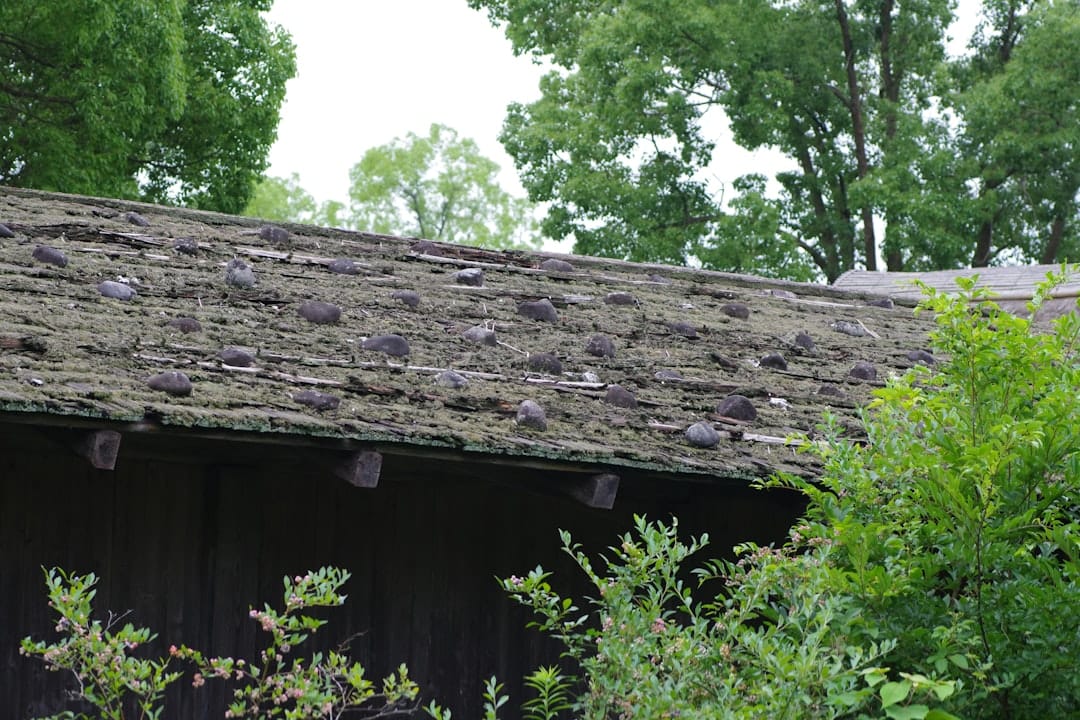Barn Roof Replacement: Ultimate Protection 2025
Barn Roof Replacement: Protect Your Barn, Preserve Your Investment
A barn roof replacement is a critical investment to protect your livestock, equipment, and feed from Texas weather. A failing barn roof requires swift action to prevent costly damage to your assets. If you want expert guidance from a trusted Sugar Land roofing company, start with our team at Sienna Roofing for straightforward advice and options tailored to agricultural buildings.
Key replacement options at a glance:
- Metal roofing – 40-70 year lifespan, excellent weather resistance, higher upfront cost
- Asphalt shingles – 15-30 year lifespan, lower initial cost, less durable in harsh weather
- Wood shakes – 20-40 year lifespan, classic appearance, high maintenance requirements
Common signs you need replacement:
- Visible leaks or water stains
- Daylight showing through roof boards
- Sagging or uneven rooflines
- Rusted or corroded metal panels
- Missing or damaged shingles
The replacement process typically takes 2-3 days for simple roofs, up to a week for complex structures. Professional installation is recommended for safety and warranty protection, especially on steep pitches or when structural repairs are needed.
I’m Andre Castro, CEO of Sienna Roofing. With a background in construction management, I’ve helped many Houston Metro property owners with their barn roof replacement decisions. My team and I will guide you through the process to protect your investment for decades.
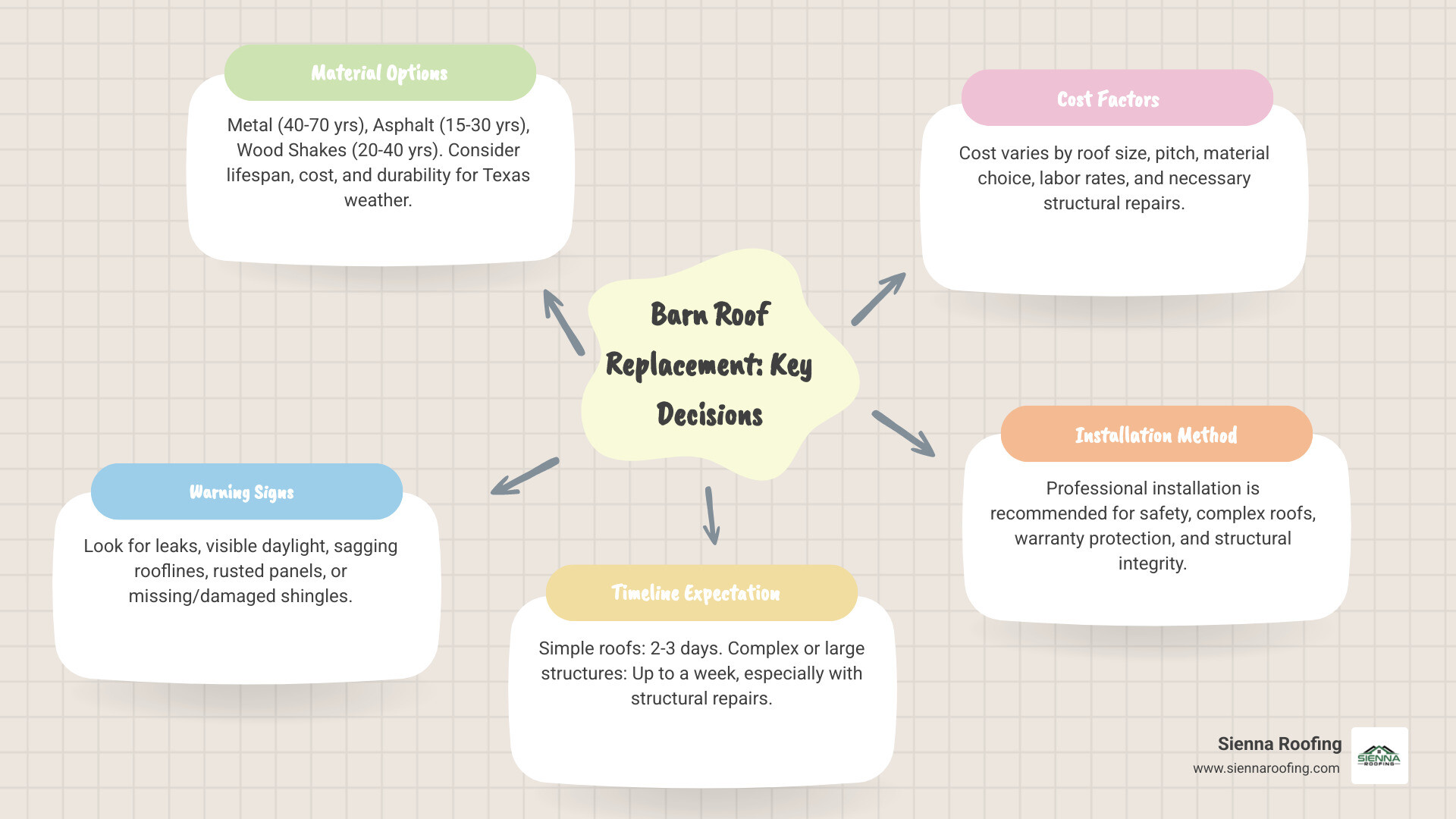
Basic barn roof replacement glossary:
Spot Problems Early: 7 Clear Signs It’s Time to Replace Your Barn Roof
Your barn withstands harsh Texas weather, but even the toughest structures show their age. Recognizing when your roof needs attention can save you thousands in damaged equipment, spoiled feed, and stressed livestock. As context, just 1 inch of rain on a 1,000 sq ft roof equals about 623 gallons of water—plenty to wreak havoc if your roof is compromised. Texas also consistently leads the nation in severe hail reports (source: NOAA Storm Events Database), accelerating wear on older roofs.
1.1 Visible Warning Signs
Walk through your barn on a sunny day to spot the most obvious red flags.
- Daylight visible through roof boards: If you can see daylight from inside your barn, rain and pests are also getting in. This is a clear sign your roof’s integrity is compromised.
- Leaks and water stains: Dark streaks or discolored patches on ceilings and walls indicate ongoing water intrusion. This moisture can lead to mold and rot, weakening the entire structure.
- Sagging or uneven rooflines: A sagging roofline points to serious structural problems, such as failing rafters or water damage. This is a safety hazard that requires immediate attention.
- Rusted or corroded metal panels: For metal roofs, rust indicates the protective coating has failed. While surface rust is a concern, deep corrosion means water is penetrating the panels.
- Curled, cracked, or missing shingles: Shingles that are curling, cracked, or missing can no longer shed water effectively, leaving your roof deck exposed to the elements.
- Rotting rafters or purlins: Soft, discolored, or decaying structural elements like rafters and purlins are a sign of long-term moisture damage. This requires immediate repair to prevent a potential collapse.
- Damage from storms or fallen branches: High winds, hail, and falling debris can puncture panels or tear off shingles, creating immediate problems that worsen quickly if not addressed.
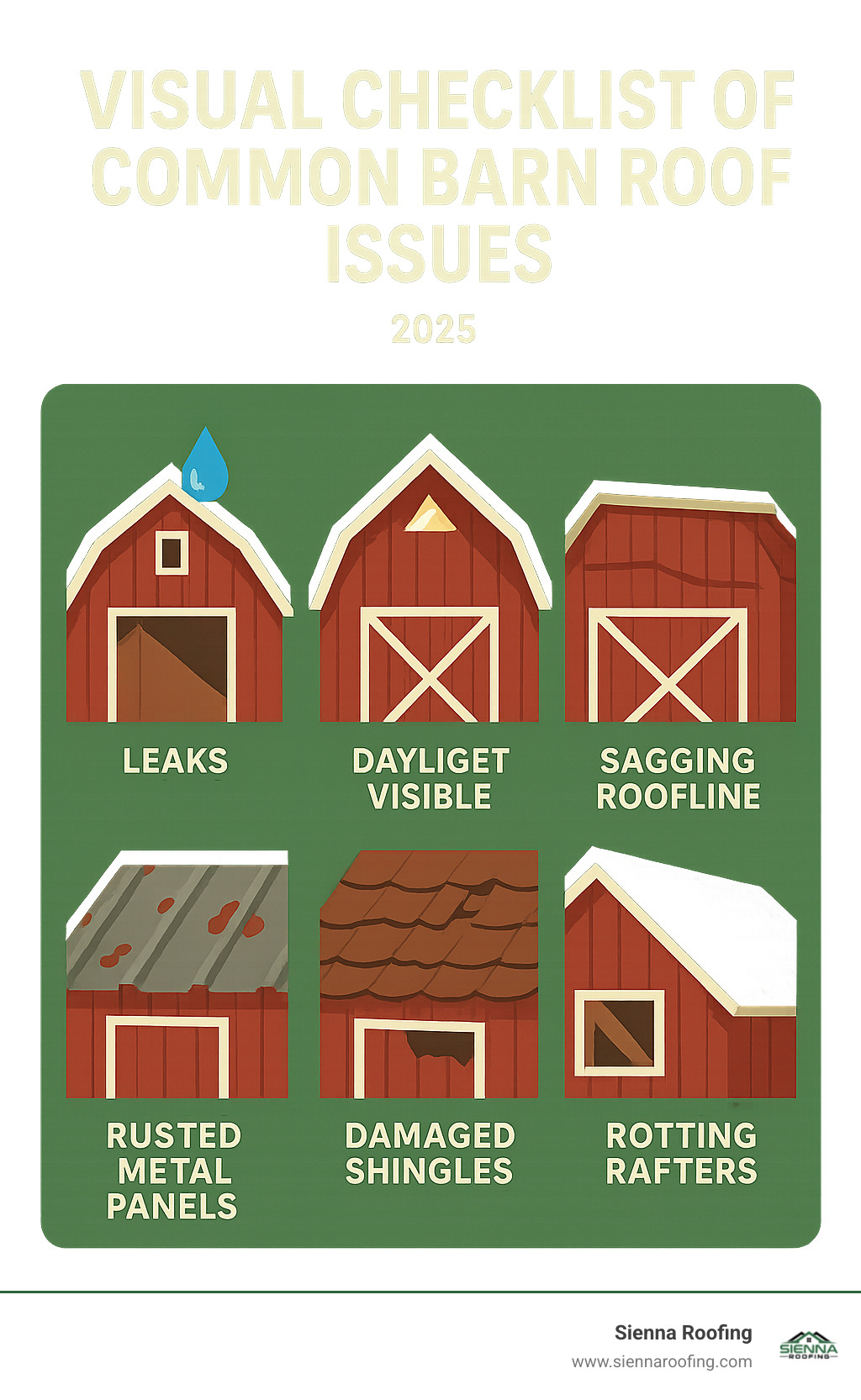
1.2 The Age Factor: When Roofs Reach the End
Sometimes a roof’s age alone is enough to warrant planning for a replacement. Different materials have predictable lifespans.
- Asphalt shingles typically last 15 to 30 years. They are less ideal for large barn roofs due to their weight and vulnerability to wind.
- Metal panels last an impressive 40 to 70 years, making them cost-effective over time despite a higher upfront investment.
- Wood shakes can last 20 to 40 years but require diligent maintenance, including regular cleaning and treatment for insects and rot. They also pose a higher fire risk.
- Hoop barn covers, or fabric-like materials, usually need replacement every 15 to 20 years.
- Laminated posts that support pole barns may need replacement within 30 to 40 years. Their failure affects the entire roof structure.
For a professional assessment of your barn roof’s condition, check out our roof inspection guide. An experienced eye can help you determine if a barn roof replacement is necessary or if repairs can extend its life.
Choose the Best Barn Roofing Material: Metal vs. Shingle vs. Wood (Lifespan, Durability, ROI)
For a barn roof replacement, your material choice is a long-term investment in protecting your livestock, equipment, and peace of mind. The right material must handle Texas’s extreme weather, from summer heat to hailstorms and winter freezes. Cool-metal options can also lower cooling energy use by roughly 10–15% in hot climates (source: U.S. DOE on cool roofs). Let’s explore the best options for your barn and budget.
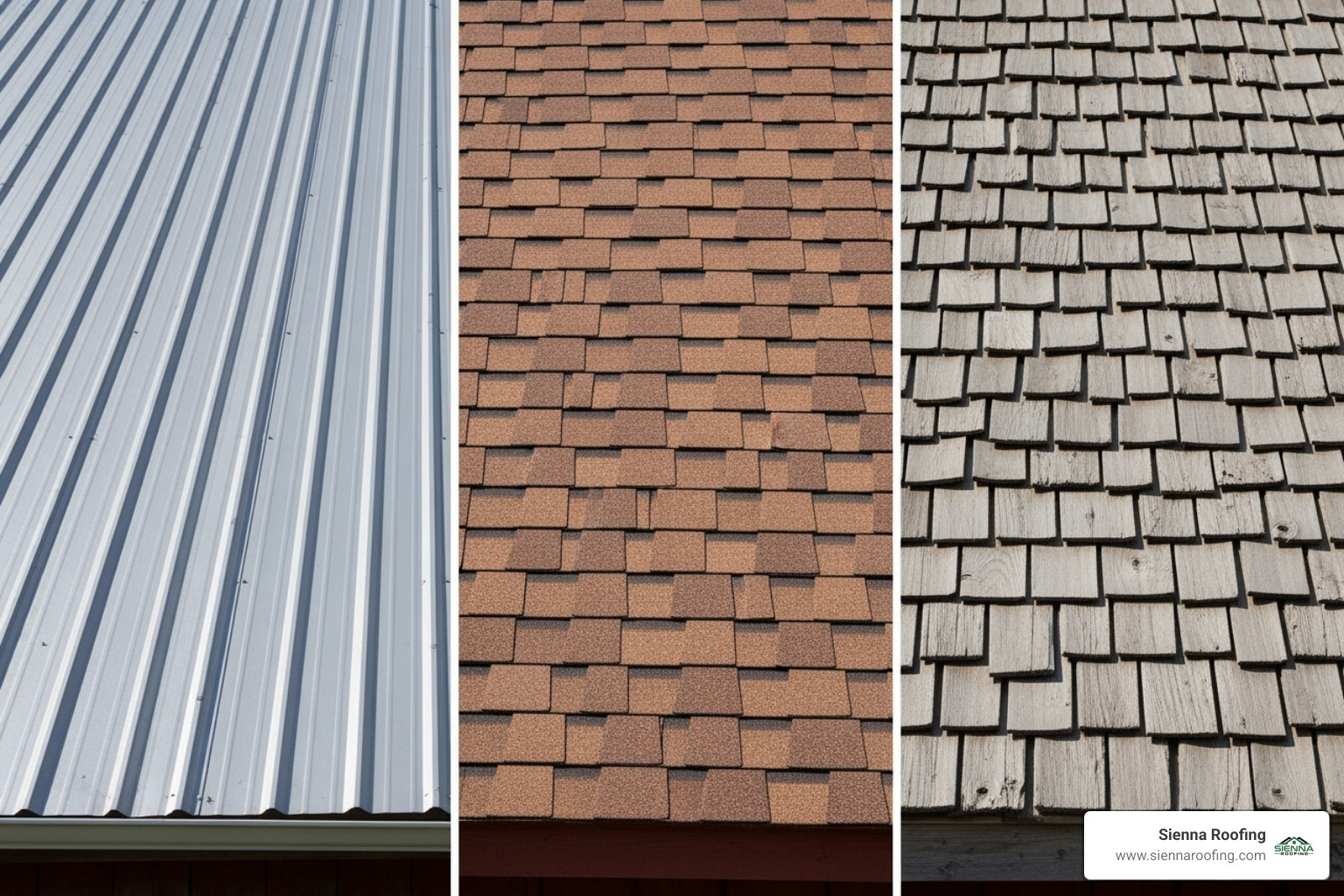
2.1 Metal Roofing: The Durable Favorite
Metal roofing is the go-to choice for agricultural buildings for good reason.
- Standing seam metal is a premium option with interlocking seams that hide fasteners, creating a sleek look and eliminating most leak points.
- Corrugated metal is the classic, cost-effective choice. Its wavy ribs provide structural strength and channel water efficiently. Thinner gauges can even be bent to fit unique roof shapes.
- Steel is durable and costs less, especially when coated for rust resistance. Aluminum is lightweight and naturally resists corrosion, making it ideal for coastal areas but at a higher price.
The 40-70 year lifespan means it’s likely the last roof you’ll install. Metal is fire-resistant, sheds precipitation effectively, and reflective options can keep your barn cooler. The main downsides are a higher upfront cost and the potential for cosmetic hail damage.
2.2 Asphalt Shingles & Wood: Traditional Choices
While metal is popular, other materials have their place.
- Asphalt shingles offer the lowest upfront cost but have a shorter 15-30 year lifespan. They are more vulnerable to high winds, are not suitable for steep barn pitches, and require solid decking, which adds to the cost. For fundamentals on product performance, see the Asphalt Roofing Manufacturers Association.
- Wood shakes offer rustic charm and can last 20-40 years with proper care. However, they require regular maintenance to prevent rot and insect damage and have a higher fire risk.
| Material | Upfront Cost | Lifespan | Durability | Maintenance |
|---|---|---|---|---|
| Metal Panels | High | 40-70 years | Excellent (wind, fire, water) | Low |
| Asphalt Shingles | Low | 15-30 years | Good (average weather) | Moderate |
| Wood Shakes | High | 20-40 years | Good (natural elements) | High |
2.3 Factors to Consider
- Texas Weather: Metal’s durability and wind resistance make it well-suited for our climate.
- Maintenance: Metal is low-maintenance, while wood shakes are high-maintenance.
- Aesthetics: A new roof improves your property’s appearance and value.
- Budget vs. Long-Term Investment: Metal’s higher initial cost is often offset by its longevity, making it more economical over time than replacing shingles multiple times.
For an in-depth comparison of all roofing materials, see our comprehensive guide: What is the best material to use for roofing in 2025? A Comprehensive Guide.
Budget Smarter: What Drives Barn Roof Replacement Cost
Understanding the factors that influence your barn roof replacement budget is key to planning your investment.
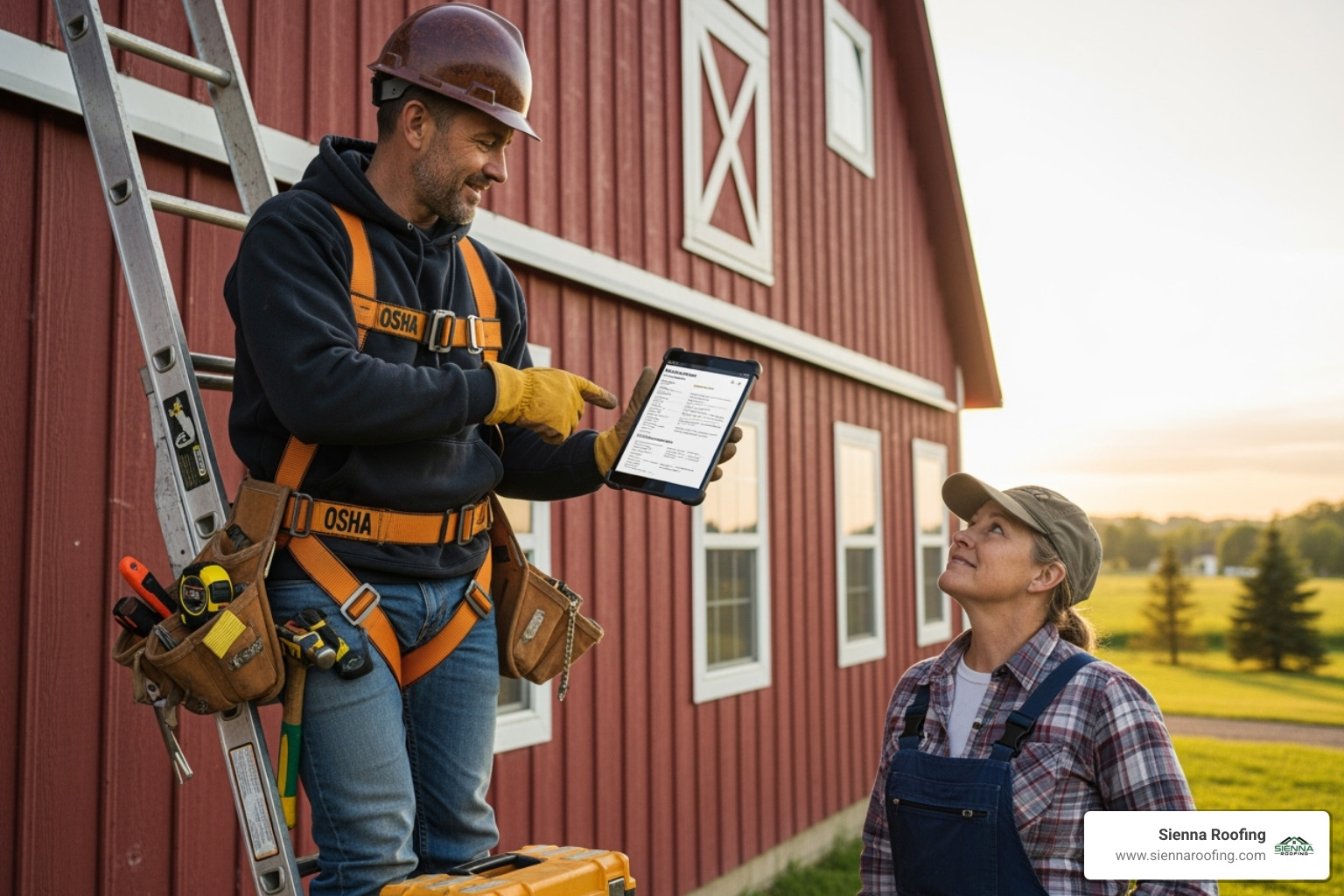
3.1 What Impacts the Cost?
- Roof size and complexity: Larger roofs cost more. Complex designs like gambrel or monitor roofs, and steeper pitches, increase labor costs due to safety needs and slower installation.
- Material choice: Metal costs more upfront than shingles. Material costs have risen industry-wide, making quality materials a more valuable long-term investment.
- Labor rates: Rates in the Sugar Land area reflect a contractor’s skill and reputation. Experienced crews prevent costly future repairs.
- Structural repairs: Unforeseen rot in purlins, rafters, or posts can add to the budget. Replacing a rotted column can cost $500 or more. A thorough inspection helps avoid surprises.
- Permit fees: Most municipalities require permits for safety compliance, which should be factored into your budget.
3.2 Climate and Location Considerations
Texas weather demands specific material choices that affect cost.
- Snow load: Though rare in some parts of Texas, potential snow accumulation must be considered in the roof’s design. Metal sheds snow easily.
- Wind resistance: Critical in open rural areas. Materials with high wind ratings prevent storm damage.
- Heat reflection: Light-colored or coated roofing can reduce interior temperatures, benefiting livestock and lowering cooling costs.
- Humidity and rust resistance: In humid regions, rust-resistant materials like galvanized steel are essential for longevity.
- Rain exposure: Fort Bend County averages roughly 50 inches of annual rainfall (NOAA climate normals), so watertight detailing and quality underlayments are non-negotiable.
Get a detailed roof replacement estimate to understand how these factors apply to your specific project.
From Tear-Off to Weather-Tight: 5 Steps to a Fail‑Safe Barn Roof Replacement
Understanding the barn roof replacement process helps you prepare and set realistic expectations. Breaking it down into clear steps makes the project much more manageable.
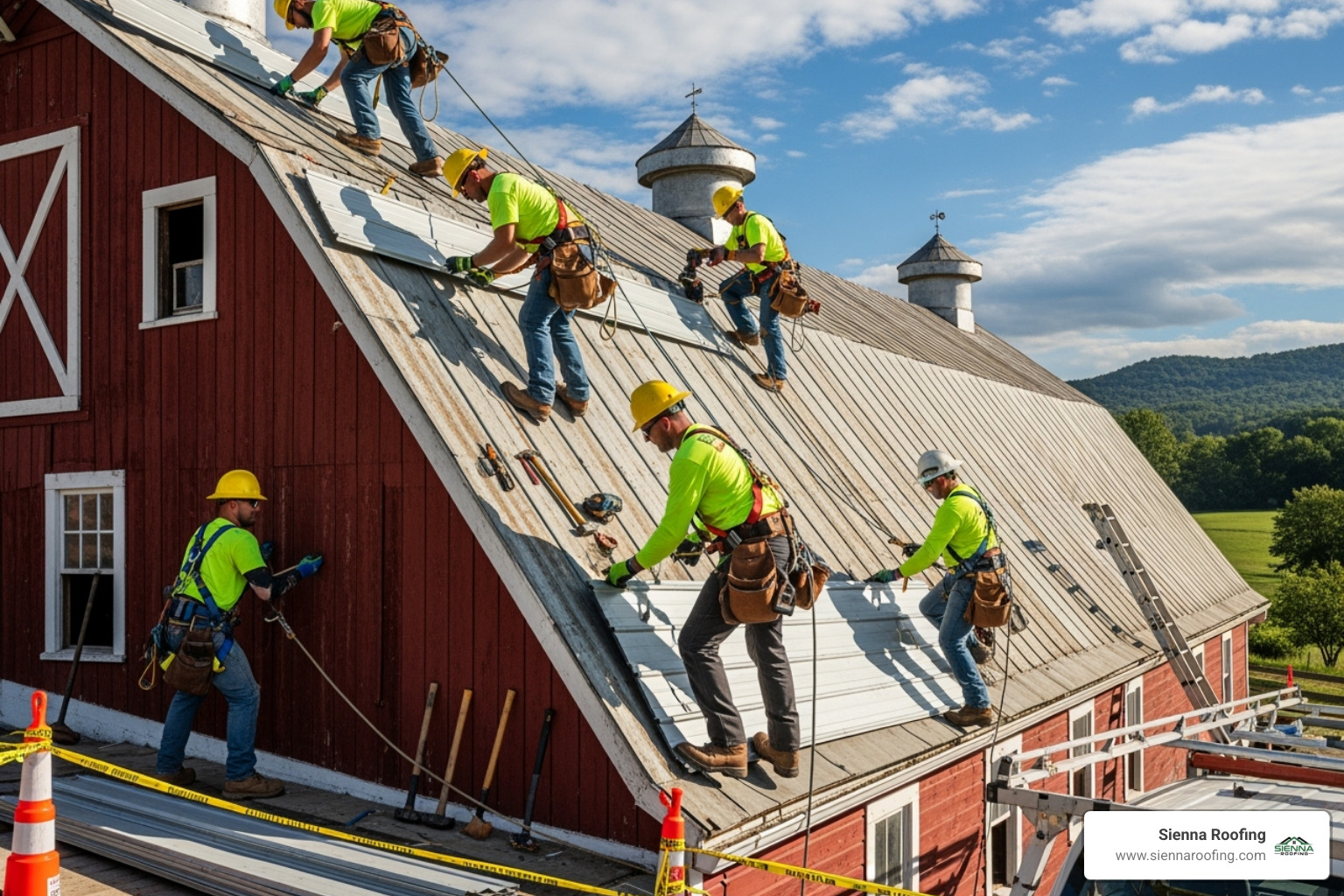
4.1 The 5 Key Steps to a Successful Replacement
Every successful barn roof replacement follows a proven sequence to ensure quality results.
- Thorough inspection and structural assessment: We examine every rafter, purlin, and post for rot or weakness. Fixing structural issues before installing a new roof is critical and cost-effective.
- Removal of old roofing material: We strip all old materials and dispose of the debris, leaving your property clean.
- Repair or replacement of damaged structure: With the old roof removed, we reinforce or replace any damaged structures like sagging purlins or weakened beams. This ensures a solid foundation for the new roof.
- Installation of new underlayment and roofing material: We install a quality underlayment for moisture protection, followed by your chosen roofing material, adhering to all manufacturer and code requirements.
- Final cleanup and inspection: We remove all debris and conduct a final walkthrough to ensure the project meets our high standards and your satisfaction.
4.2 DIY vs. Professional Installation: What’s Right for You?
This decision involves weighing potential savings against safety and quality.
- DIY: While it can save on labor costs, the safety risks from falls are significant. Inexperience can lead to costly errors like improper fastening or structural miscalculations, which often cost more to fix than hiring a pro. A barn roof replacement is also a major time commitment. Falls are a leading cause of construction fatalities—about one-third of deaths in the sector (source: OSHA).
- Professional Installation: This is essential for complex or steep roofs and structural repairs. Professionals bring experience, proper equipment, and efficiency. Our warranties and liability insurance protect your investment and give you peace of mind. For most large projects, the benefits of professional installation outweigh the potential DIY savings.
For expert installation in the Sugar Land area, contact our experienced roofing team who prioritize both quality and safety in every project we complete.
Why Barn Owners Trust Sienna Roofing in Sugar Land
When your barn roof fails, you need a partner who understands agricultural properties. At Sienna Roofing, we provide personalized, community-driven service throughout the Sugar Land, Missouri City, and Richmond areas. We know your barn protects your livelihood—valuable livestock, equipment, and feed. That’s why we treat every barn roof replacement with the care we’d give our own property.
What sets us apart is our commitment to being more than just roofers. We manage every detail of your barn roof replacement, from the initial structural assessment to removing old materials, repairing the underlying structure, and installing a new, high-quality roofing system built for Texas weather.
Our 100% satisfaction guarantee means we stand behind our work long after the project is complete. We don’t consider a job finished until you’re completely satisfied with our workmanship and the overall experience.
Contact Information:
- Name: Sienna Roofing
- Address: 17034 University Blvd, Sugar Land, TX 77479
- Phone: Click to call: (832) 564-3322
Ready to protect your barn with a roof that will last for decades? Give us a call today for your free consultation and estimate. We’re here to help you make the best decision for your property and budget.
Barn Roof Replacement FAQs: Timelines, Overlay Options, and Permits
Facing a barn roof replacement brings up many questions. Here are answers to the most common concerns we hear from barn owners in the Sugar Land area.
How long does a barn roof replacement take?
The timeline depends on the project’s complexity. For small, simple roofs, the process typically takes 2–3 days, assuming good weather and a solid structure. Large or complex roofs with gambrel designs, steep pitches, or those requiring structural repairs can take a week or more.
Can I install a new metal roof over old shingles?
We do not recommend it. Metal and asphalt expand and contract at different rates, causing the old shingles to act like sandpaper against your new roof. A full tear-off is the best practice. It allows us to inspect the underlying structure for rot or damage and ensures the longevity of your investment.
Do I need a permit to replace my barn roof?
Yes, most municipalities require a permit to ensure the work meets current safety and building codes. Regulations vary by location, so it’s important to check local requirements. When you partner with Sienna Roofing, we handle the entire permitting process for you.
Protect Your Barn for Decades—Get a Free, No‑Pressure Estimate
Your barn roof replacement is a crucial investment in your agricultural operation’s future. By understanding the warning signs, choosing the right materials, and following a professional process, you protect your livestock, equipment, and feed for years. A new roof also improves energy efficiency—especially with reflective metal—and boosts your property’s value.
Don’t let a failing roof put your hard work at risk. Water damage happens quickly, destroying feed, damaging equipment, and threatening your animals. Delaying repairs only makes the problem more expensive.
At Sienna Roofing, we’ve helped countless barn owners throughout Sugar Land and the surrounding areas make this important decision. We understand that your barn is the heart of your operation, and we bring the care and attention to your barn roof replacement that we would to our own family’s property.
Ready to get started? Contact Sienna Roofing today for a free consultation and estimate! We’ll walk through your specific situation, answer all your questions, and provide a detailed plan that fits your budget and timeline. Let us help you ensure your barn serves you well for decades to come.
